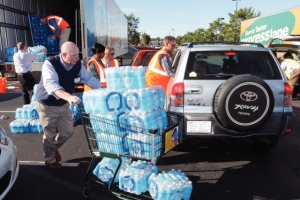Floodwater is not safe, exercise precaution
By From staff reports
Published in News on October 12, 2016 9:57 AM

News-Argus/STEVE HERRING
Two truckloads of water and ice will be given out today at Harris Teeter on Wayne Memorial Drive. Ice and clean water are at a premium because of Hurricane Matthew, and Tuesday afternoon Harris Teeter employees gave away 1,500 cases of free bottled water and 4,000 10-pound bags of bags of ice in the store's parking lot on Wayne Memorial Drive. To speed up the process vehicles were divided into two lines. However, traffic was still backed on U.S. 70 West as traffic exited onto Wayne Memorial Drive. Traffic was also up across the bridge over U.S. 70.
When returning to your home after a hurricane or flood, be aware that flood water may contain sewage.
The North Carolina Department of Public Safety offers the following ways to protect yourself and your family by following these steps:
Inside the Home
* Keep children and pets out of the affected area until cleanup has been completed.
* Wear rubber boots, rubber gloves and goggles during cleanup of affected area.
* Remove and discard items that cannot be washed and disinfected such as mattresses, carpeting, carpet padding, rugs, upholstered furniture, cosmetics, stuffed animals, baby toys, pillows, foam-rubber items, books, wall coverings and most paper products.
* Remove and discard drywall and insulation that has been contaminated with sewage or flood waters.
* Thoroughly clean all hard surfaces (such as flooring, concrete, molding, wood and metal furniture, countertops, appliances, sinks and other plumbing fixtures) with hot water and laundry or dish detergent.
* Help the drying process by using fans, air conditioning units and dehumidifiers.
* After completing the cleanup, wash your hands with soap and warm water. Use water that has been boiled for 1 minute (allow the water to cool before washing your hands).
* Or you may use water that has been disinfected for personal hygiene use (solution of an eighth of teaspoon (approximately 0.75 milliliters) of household bleach per 1 gallon of water. Let it stand for 30 minutes. If the water is cloudy, use a solution of a quarter of a teaspoon (approximately 1.5 milliliters) of household bleach per 1 gallon of water.
* Wash all clothes worn during the cleanup in hot water and detergent. These clothes should be washed separately from uncontaminated clothes and linens.
* Wash clothes contaminated with flood or sewage water in hot water and detergent. It is recommended that a laundromat be used for washing large quantities of clothes and linens until your on-site waste-water system has been professionally inspected and serviced.
* Seek immediate medical attention if you become injured or ill.
For more information visit www.cdc.gov/disasters/floods/cleanupwater.html.
* Reentering your flooded home: www.cdc.gov/disasters/mold/reenter.html.
* Mold after a disaster: www.cdc.gov/disasters/mold.
* Cleaning and sanitizing with bleach after an emergency: www.cdc.gov/disasters/bleach.html.
Outside the Home
* Keep children and pets out of the affected area until cleanup has been completed.
* Wear rubber boots, rubber gloves and goggles during cleanup of affected area.
* Have your on-site wastewater system professionally inspected and serviced if you suspect damage.
* Wash all clothes worn during the cleanup in hot water and detergent. These clothes should be washed separately from uncontaminated clothes and linens.
* After completing the cleanup, wash your hands with soap and warm water. Use water that has been boiled for 1 minute (allow the water to cool before washing your hands).
* Or you may use water that has been disinfected for personal hygiene use -- a solution of an eighth of a teaspoon (approximately 0.75 milliliters) of household bleach per 1 gallon of water). Let it stand for 30 minutes. If the water is cloudy, use solution of a quarter of a teaspoon (approximately 1.5 milliliters) of household bleach per 1 gallon of water.
* Seek immediate medical attention if you become injured or ill.
Septic systems
* Caution: Do not drink well water until you know it is safe. Use a safe water supply like bottled or treated water (learn how to make water safe (www.cdc.gov/healthywater/emergency/drinking/making-water-safe.html).
* Be aware that flood water may contain sewage. For more information about how to protect yourself and your family, visit Centers for Disease Control's "After a Hurricane or Flood: Cleanup of Flood Water."
Precautions related to septic systems include:
* Avoid contact with any septic system electrical devices until they are dry and clean.
* Do not pump out the septic tank more than halfway or the tank may float out of the ground.
* Reduce all nonessential water use (for example, dishwashing, washing clothes, showering).
* lush toilets as little as possible or use a temporary toilet.
* If you suspect septic system damage, get the system professionally inspected and serviced. Contact your health department for a list of septic system contractors who work in your area.
Cleaning up floodwater: www.cdc.gov/disasters/floods/cleanupwater.html.
Wash clothes contaminated with flood or sewage water in hot water and detergent. It is recommended that a laundromat be used for washing large quantities of clothes and linens until your on-site wastewater system has been professionally inspected and serviced.
Also visit www.cdc.gov/healthywater/emergency/sanitation-wastewater/septic.html and http://nasdonline.org/1970/d001564/flooded-private-sewage-systems-safety-sanitation-and-clean.html.
